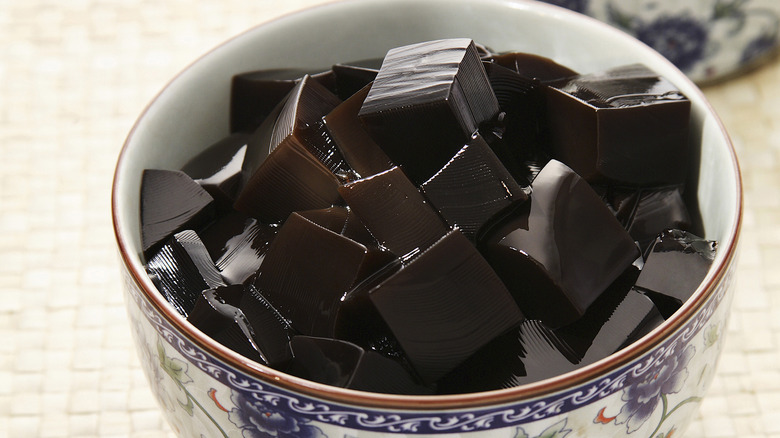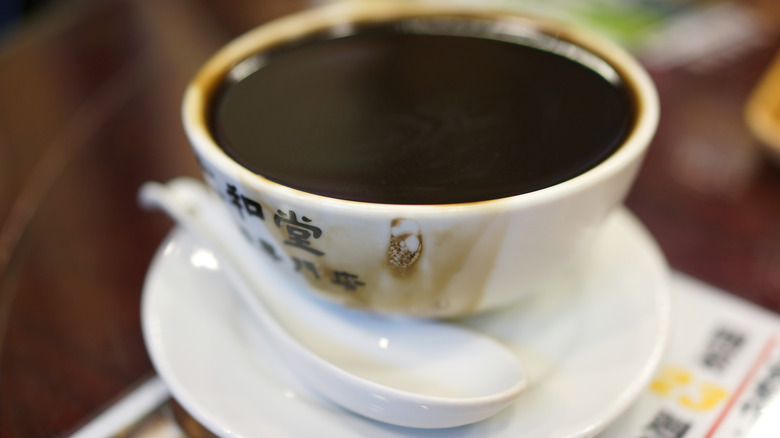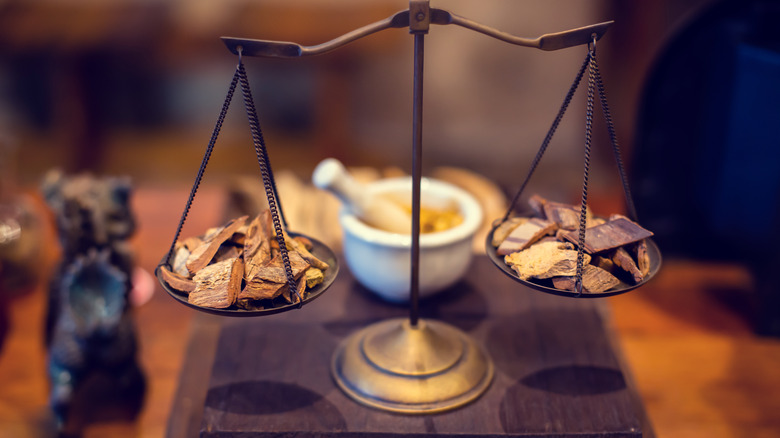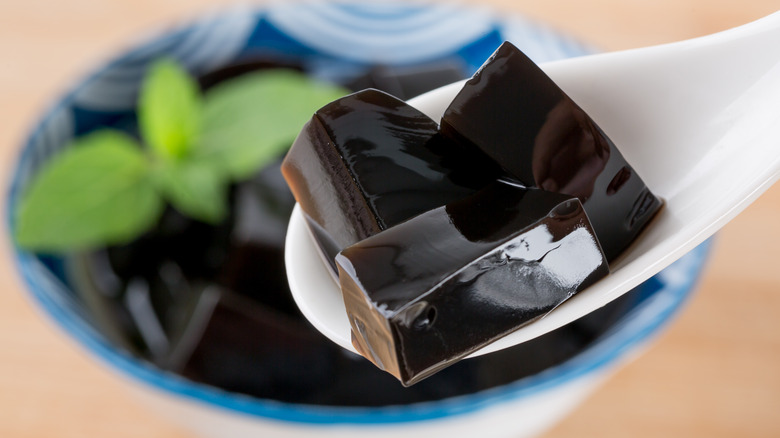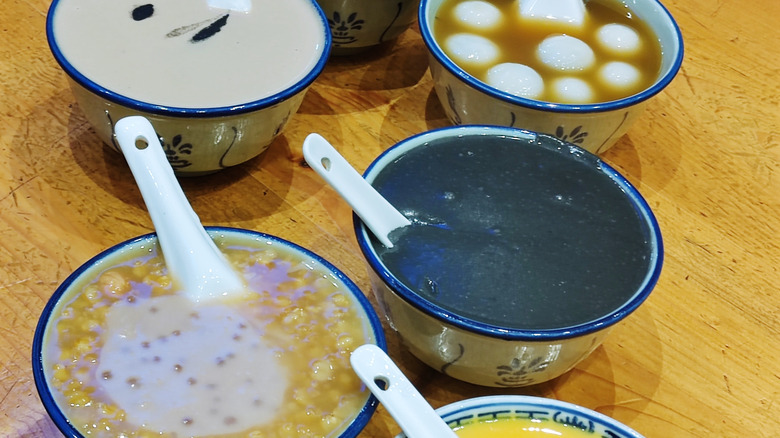Guilinggao, The Traditional Chinese Medicine That Moonlights As A Popular Dessert
Sitting in a Hong Kong-style cafe, you discover an enigmatic dessert on the menu called guilinggao (龟苓膏) — commonly known as tortoise jelly in China — and you decide to order it. Shiny, jet-black cubes that immediately command your attention arrive in an ornate porcelain bowl. You scoop up a heaping spoonful with a Chinese soup spoon and take a bold bite: The cold jiggling jelly, drizzled with simple syrup, is soft — as expected — and not too sweet, with a noticeably bitter aftertaste. Still, it's pleasant, earthy, and herbal, a little like licorice, and very refreshing.
Far from being just a dessert novelty, this dish harbors a rich history that stretches back to the annals of the Qing Dynasty in China. Originally created with the crushed shells of golden coin turtles (now a critically endangered species) and various medicinal herbs, tree bark, flowers (like honeysuckle), and sometimes spices, guilinggao is a traditional Chinese herbal medicine that moonlights as the popular dessert you're relishing. And today, it's usually vegan, containing no turtles in the ingredients list.
A purported medicinal marvel of a dessert with a rich history
Deeply embedded in history and traditional Chinese medicine (TCM), guilinggao has a status across China and Asian diasporas as a culinary and medicinal marvel. Although some legends trace its origins back to the Three Kingdoms era — between A.D. 220 and 280 — the dish gained significant prominence during the Qing Dynasty in the 1800s. During that period, the tale goes that Emperor Tongzhi experienced a miraculous (if ultimately temporary) recovery from smallpox after consuming this unique jelly.
In the realm of TCM, guilinggao serves as a health tonic with "cooling" properties. It employs an intricate blend of herbs designed to clear bodily "heat." Each ingredient purportedly carries a specific medicinal intent, ranging from alleviating muscle rigidity and joint pain to promoting blood circulation and reducing inflammation. Some studies even suggest that guilinggao aids in toxin removal and boosts urine output (per BioMed Research International), although the dish's complex and varied list of ingredients calls for more comprehensive research.
For those wondering about its applicability for all, TCM advises caution: Young children under 5 and women who are either pregnant or menstruating should steer clear of guilinggao due to its "blood-cooling" effects. This caution underscores the need for consumers to consider both the culinary and medicinal aspects of guilinggao before enjoying it. And of course, as it has medicinal properties, it should be enjoyed in moderation.
It's as easy to make guilinggao as it is to make JELL-O
Traditionally, making authentic guilinggao relied on the use of the golden coin turtle's shell. First, one would clean the turtle shells meticulously before setting them out to air-dry. After that, you would crush the dried shells into a fine powder, which acted as the foundational ingredient for the black jelly dish. To this core component, you'd add a medley of about 15 different medicinal herbs; once the herbal medley and liquid were thoroughly mixed, the slow-cooking process would commence. Hours of gentle simmering would result in the liquid evaporating, with subsequent cooling producing a dark jelly.
Since golden coin turtles are critically endangered and costly, it's hard nowadays to find "authentic" guilinggao made with the animal. Most guilinggao is now prepared with pre-packaged guilinggao powder that contains different Chinese herbs but no turtles. To make the black jelly dessert with guilinggao powder, cook it like you would cook JELL-O: Boil water, mix in the powder, transfer to a container or its final serveware, and cool until set. Serve after chilling, drizzled with syrup, honey, or sweetened condensed milk — or serve the sweetener on the side.
Enjoy guilinggao as a dessert or a dessert topping
Beyond the realm of box mixes, ready-to-eat guilinggao appears in various formats. Whether on the shelves of Asian supermarkets, in online stores, or at local bakeries, consumers can find this unique jelly in cans or convenient plastic containers.
When it comes to serving and enjoying guilinggao, options abound. The classic method portions the jelly into uniform cubes, either large or small, served in bowls. Another approach invites a more casual experience — simply scooping spoonfuls directly from a bowl. Given the jelly's inherently bitter profile, many choose to temper its flavor with liquid sweeteners like honey or syrup. A sprinkling of brown sugar also works well, lending a molasses-like depth to the herbal notes of the jelly.
For a more elaborate presentation, you can layer guilinggao in a parfait glass with fruits like lychee or mango, adding a tropical twist. Alternatively, you might incorporate it into a traditional Chinese sweet soup, mingling with ingredients like red bean or lotus seed or even mochi bites for a multi-textured experience. Some people even use it as a topping on shaved ice, where its cooling properties complement the frosty base, making it an ideal treat for hot summer days. Finally, you can enjoy it as a boba topping, though another black jelly, grass jelly, is usually more prevalent in bubble tea.
Herbal desserts beyond guilinggao
In modern times, dishes like guilinggao continue to adapt and evolve, giving way to variations that cater to contemporary tastes and ethical concerns. Traditionalists might raise an eyebrow, but plant-based versions are growing in popularity. Grass jelly is another black jelly with an herbal base made from mesona leaves; it also boasts cooling properties but lacks the complex herbal medley of guilinggao. Then there's the realm of herbal teas like chrysanthemum or ginseng, offering the same "cooling" philosophy but in a sippable form. Consider these teas, especially the dark and black ones, the liquid counterparts to guilinggao, offering its benefits in a different medium. Chinese herbal syrup medicines such as pei pa kao, a loquat syrup, also share the medicinal-sweet space and have been drizzled over ice cream and gone viral on social media.
For those intrigued by dark-colored desserts but who want to try something less medicinal, consider black sesame soup or black sesame jelly. Like guilinggao, this inky-black concoction has roots in TCM and is said to offer health benefits alongside its delicious taste. Primarily made from finely ground black sesame seeds, rice flour, and sugar, this warm, velvety soup is often enjoyed as a dessert or even a breakfast item. Unlike guilinggao, however, black sesame has warming properties, making it ideal for colder weather and those who seek something nourishing. But just like guilinggao, desserts like black sesame soup bridge the gap between herbal remedies and enjoyable treats, making them timeless and popular.
